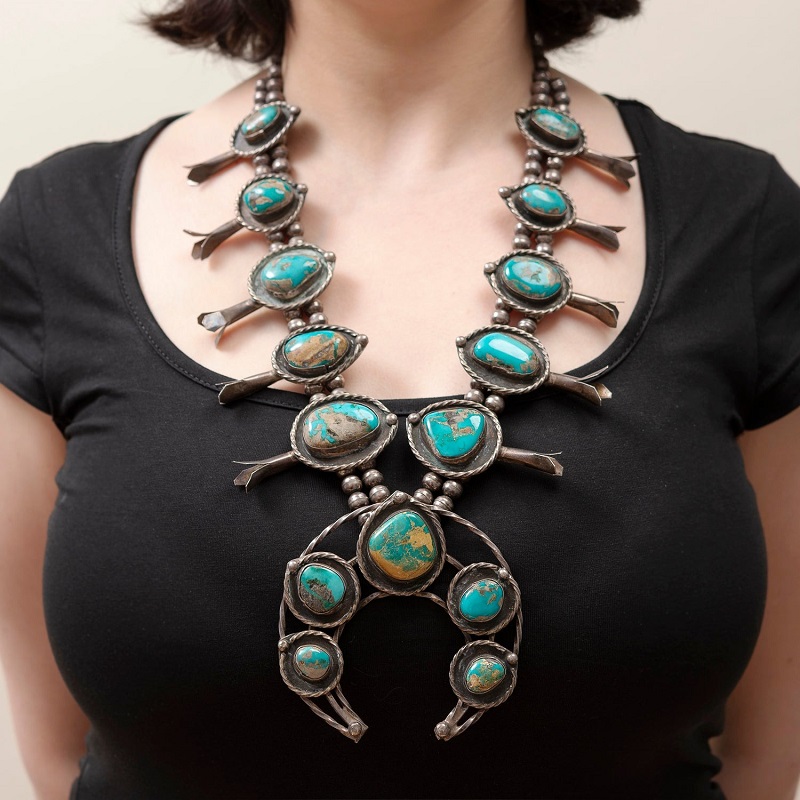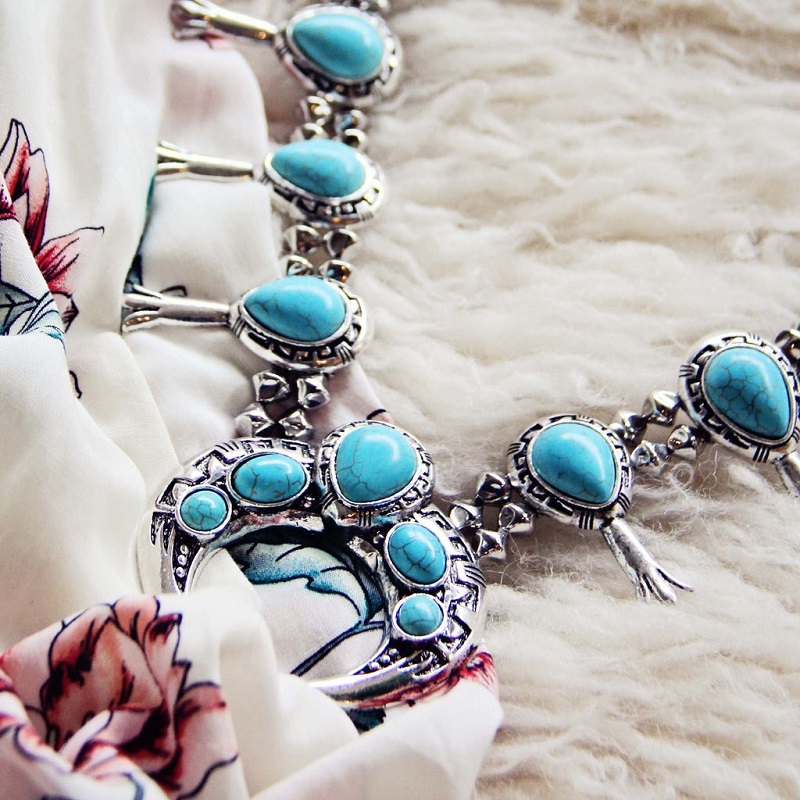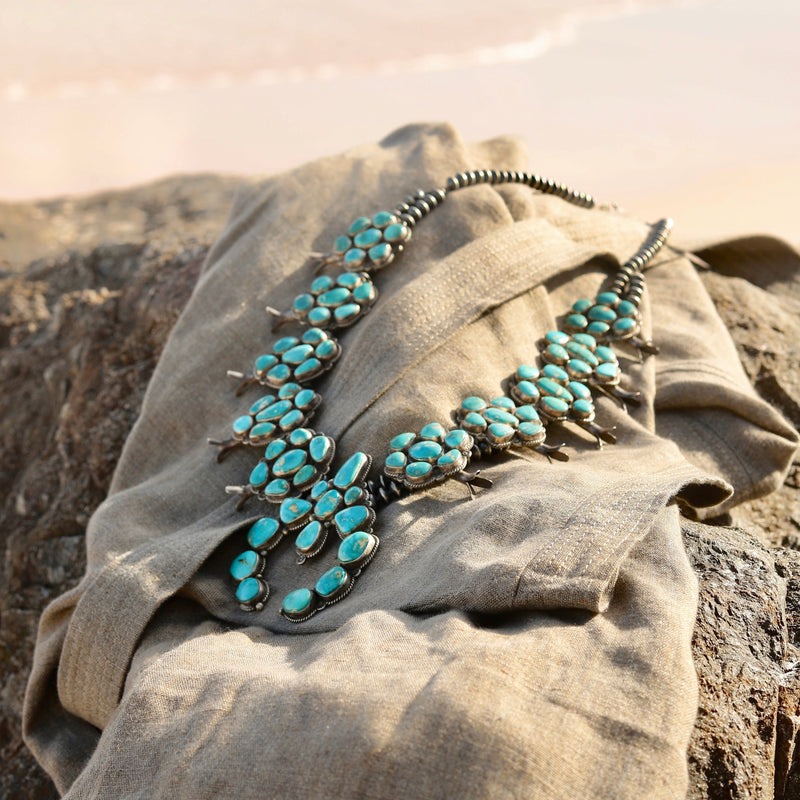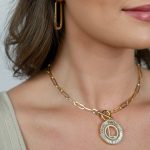Determining the age of a squash blossom necklace is essential for collectors, jewelry enthusiasts, and anyone interested in Native American art. These exquisite pieces not only carry aesthetic value but also represent rich cultural heritage. In this article, we will explore the essential aspects of how to determine age of squash blossom necklace.
Introduction to Squash Blossom Necklaces
Squash blossom necklaces symbolize the rich heritage of Native American jewelry. These distinct pieces are known for their unique design, which includes a ‘naja’ pendant and ‘squash blossoms’ — flower-like shapes linked by silver beads. The history of squash blossom necklaces dates back to the 1800s, reflecting a fusion of Native American culture with European influences. Over time, these necklaces have become coveted collectibles due to their beauty and craftsmanship.
Identifying the age of a squash blossom necklace can be fascinating. It requires a close examination of various features. Details such as the style of the beads, the construction method, and the materials used can reveal much about the era in which a necklace was made. Maker’s marks or hallmarks, if present, can also provide valuable clues. Additionally, the number of blossoms or the quality of turquoise may have significance in determining the piece’s vintage. Understanding these elements is essential to appreciate fully and accurately date a squash blossom necklace.
In the upcoming sections, we will delve into the key features that help to determine the age of a squash blossom necklace, including the maker’s marks, materials, craftsmanship, and more.
Key Features of Vintage Squash Blossom Necklaces

When trying to determine the age of a squash blossom necklace, several key features are crucial. Vintage squash blossom necklaces often exhibit certain attributes that can provide valuable insight into their historical period. Here we explore these features more closely.
Maker’s Marks and Hallmarks
Vintage squash blossom necklaces sometimes bear maker’s marks or hallmarks, unique signatures of artisans or tribes. These marks often appear on the back of the necklace’s naja (the central pendant) or on individual blossoms. In older pieces, marks may be absent, as hallmarking wasn’t common practice until later years. Traders’ codes or pawn shop markings could also be mistaken for maker’s marks in some instances. Precise identification of these marks can guide you to a more accurate date.
Blossom Count
The number of blossoms on a necklace can hint at its age. Earlier designs tended to have fewer blossoms, commonly ranging from four to six per side. A necklace with a higher number of blossoms, like seven or more, could indicate a piece made in a period where more elaborate designs were in fashion or might be a sign of a custom order.
Materials Used
Materials used in the creation of squash blossom necklaces can reveal much about their age. Earlier necklaces often utilized natural turquoise, which changes color over time, and coins or ingot silver. The use of these materials suggests that a necklace may be an older, authentic piece. In contrast, necklaces with stabilized turquoise or commercial-grade silver could point to a more modern era.
Craftsmanship
The craftsmanship of a squash blossom necklace is another tell-tale sign of its vintage. Handmade beads and hand-wrought silver indicate older, potentially pre-1940s pieces. Heavier, high-quality silver work with intricate, refined designs might come from the mid-20th century. More recent necklaces might display signs of machine pressing or modern manufacturing techniques.
By understanding these features, you can begin to piece together the history of a squash blossom necklace. Remember, thorough examination and expert consultation are often necessary to accurately determine the necklace’s age.
Analyzing Maker’s Marks and Hallmarks
When exploring the age of a squash blossom necklace, analyzing maker’s marks and hallmarks is crucial. These marks are typically engraved or stamped on the necklace’s naja or sometimes on the individual blossoms. Understanding these marks can be the key to identifying the era of the piece.
Identifying Maker’s Marks
Maker’s marks are unique symbols or initials left by the artisan. These can indicate the specific creator or the tribe from which the necklace originated. Earlier pieces might lack these marks as hallmarking was not a widespread practice until the later periods. It is important to consult an expert or use a hallmark guide specific for Native American jewelry to ensure accurate identification.
Distinguishing Pawn Shop Codes and Traders’ Marks
In some cases, what may appear as a maker’s mark could actually be a pawn shop code or a trader’s mark. These were used historically for inventory or pricing reasons and are not indicative of the artisan. Recognizing the difference between these marks and true maker’s marks is essential for correct dating.
Importance of Hallmarks in Dating
The presence of hallmarks can significantly aid in dating a squash blossom necklace. Artisans started regularly including these marks around the mid-20th century, so their presence can often point to a more modern creation. Conversely, the absence of a hallmark might suggest an older, possibly pre-1940s necklace.
In summary, a detailed examination of maker’s marks and hallmarks provides invaluable information that helps to determine the age of squash blossom necklaces. Accurate interpretation of these marks, however, often requires specialized knowledge or the input of an experienced jeweler or appraiser.
The Significance of Blossom Count in Dating Jewelry
The number of blossoms on a squash blossom necklace is not just an artistic choice. It also holds clues to the necklace’s creation date. Early squash blossom necklaces typically had a modest number of blossoms. Usually, you would see four to six per side. This is a common feature of such necklaces crafted in the 1800s to early 1900s.
However, as design preferences evolved, necklaces with more blossoms began to appear. By the mid-20th century, some necklaces sported seven or even more blossoms per side. Such an increase often reflects a trend towards more lavish designs during that period. It can also point to a custom-made piece, where the client’s preferences played a significant role.
Collectors and enthusiasts should pay careful attention to the blossom count. It’s not just about aesthetics. The number can often guide you toward a more accurate estimate of the piece’s age. When trying to determine the age of a squash blossom necklace, count the blossoms. Then, cross-reference this detail with historical trends in Native American jewelry design.
In summary, blossom count is a valuable indicator in dating squash blossom necklaces. Fewer blossoms often suggest an earlier piece. In contrast, a higher blossom count could indicate a necklace from a more recent era or a specially commissioned item.
The Role of Materials and Craftsmanship in Determining Age

When estimating the age of a squash blossom necklace, materials and craftsmanship play a pivotal role. By analyzing these two elements, one can often deduce the historical timeline of a piece’s creation.
Examining the Materials
Materials used in squash blossom necklaces serve as time capsules, offering insight into the era they were made. Early necklaces often featured coins or ingot silver, and natural turquoise – known for its color changing over its lifetime. These indicate a piece might be from the 1800s or early 1900s.
Conversely, modern necklaces may use stabilized turquoise, signaling a more recent creation. Likewise, commercial-grade silver may suggest a piece is not as old as those fabricated from coin or ingot silver.
Assessing Craftsmanship
The quality and style of craftsmanship in squash blossom necklaces also reveal clues about their age. Early pieces boast handmade beads and hand-forged silver, indicative of pre-1940s work. This type of intricate, painstaking craftsmanship denotes an attention to detail typical of earlier times.
Mid-20th century necklaces often feature detailed silver work, reflecting advances in jewelry-making techniques. Machine pressing and modern manufacturing methods became more prevalent later in the century, so necklaces with such traits tend to be more recent.
By closely examining the materials and craftsmanship of a squash blossom necklace, you can piece together its age. Evaluate each element: Is the turquoise natural or stabilized? Is the silver hand-wrought or commercially processed? Such questions are key to unlocking the history of these ornate necklaces.
Importance of Construction: Handmade vs Machine-Pressed
The construction method of a squash blossom necklace is a clear indicator of its age. High-quality handmade necklaces suggest a labor-intensive creation process typical of older, traditional pieces while machine-pressed components often indicate contemporary manufacturing.
Handmade Characteristics to Look For
When examining a necklace, inspect for signs of handcrafting: irregularities in bead shapes, asymmetrical blossoms, and individualized silverwork. Each handmade item is unique, devoid of the uniformity you’d find in mass-produced jewelry.
Machine-Pressed Indicators
In contrast, machine-pressed necklaces present with remarkable consistency in shape and design. Modern pieces typically exhibit uniform beads and blossoms, a telltale sign of recent production methods. These necklaces are often lighter and less intricate than their handmade counterparts.
Assessing the Impact on Age
Understanding the difference between handmade and machine-pressed necklaces is central to gauging their vintage. Handcrafting points to an earlier creation—possibly before the mid-20th century. Conversely, machine production suggests a more modern time frame. Always assess the method of construction to accurately date a squash blossom necklace.
Understanding Turquoise Quality and Its Impact on Necklace Age
Turquoise is often a highlight in squash blossom necklaces. Its quality can point to the piece’s age. When considering turquoise, examine its nature and condition.
Assessing Natural vs Stabilized Turquoise
Older necklaces tend to feature natural turquoise, which may change color over time. This is due to exposure to skin oils and the environment. Modern pieces might use stabilized turquoise, less prone to color variation. The natural kind often signals an older, possibly antique piece.
Turquoise Color Change and Age
Another aspect is color. Natural turquoise can darken or alter hue as it ages. This creates a patina that collectors value. If the turquoise shows considerable color change, suspect an older necklace.
Turquoise Source and Its Significance
The origin of turquoise is important. Certain mines produce stones that became scarce over time. Thus, turquoise from these mines may certify the necklace as vintage.
Examining Turquoise Setting
How turquoise is set into the necklace can reveal age clues. Hand-cut bezels and crude settings are typical of early pieces. However, perfect cuts and settings may indicate newer techniques and machinery.
In essence, turquoise’s quality and treatment are influential in dating a squash blossom necklace. Natural, color-changing stones set in handcrafted bezels are a hallmark of age. These factors help experts and collectors alike estimate a necklace’s age with accuracy. Keep these tips in mind when examining squash blossom necklaces for age determination.
Expert Tips for Dating Squash Blossom Necklaces

When trying to date a squash blossom necklace, expert guidance can be invaluable. Below are some specialized tips for accurately determining the age of these Native American pieces.
Consult with Specialty Collectors and Dealers
Reaching out to collectors who specialize in Native American jewelry can be highly beneficial. They often hold a wealth of knowledge about specific styles and historical trends.
Use Hallmark Guides as Reference
Invest in a good hallmark guide. These books provide information on hallmarks and can help you identify the creator of the necklace.
Examine Wear and Patina
Assess the wear and patina on the necklace. Noticeable wear or smoothing of silver from years of handling suggests an older necklace.
Look at the Clasp Type
Different clasps have been used throughout history. Look at the type and construction of the necklace’s clasp for age clues.
Attend Antique Shows and Auctions
Visiting antique shows and jewelry auctions can offer insights and the chance to compare your piece directly with known dated items.
Get a Professional Appraisal
For a definitive age determination, consider getting a professional appraisal. Experienced appraisers can provide a detailed analysis.
By following these tips and combining the information with the previous sections, you can gain a clearer picture of the age of a squash blossom necklace.
Conclusion: Synthesizing Information to Date Your Necklace
Determining the age of a squash blossom necklace can be an enriching experience. It involves combining various clues. Inspect maker’s marks, count blossoms, and identify materials and craftsmanship. Look closely at the construction, and evaluate the turquoise quality. Consulting hallmark guides can help decipher artisan signatures. Connect with specialty collectors for their seasoned perspectives.
When examining a necklace, note the number of blossoms. This can signal the time frame of its creation. Research the types of materials used, particularly the silver and turquoise. Assess whether the beads and blossoms are handcrafted or machine-pressed. Each detail will inch you closer to its true age.
Seek expert advice where necessary. An appraiser can give you an accurate estimate of the necklace’s age. They can assess factors like wear, patina, and clasp style. Antique shows and jewelry auctions also serve as great platforms for learning.
In conclusion, dating a squash blossom necklace is a detailed process. It blends historical knowledge with careful observation. Take your time and use the tips mentioned throughout this guide. With patience and the right resources, you can uncover the story behind your cherished piece.

